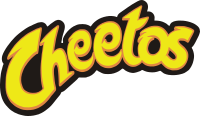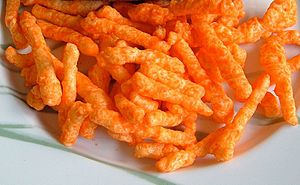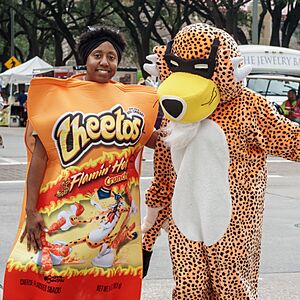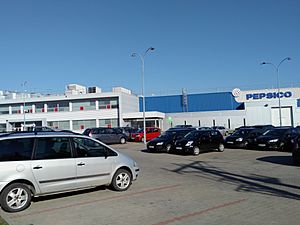Cheetos facts for kids
 |
|
 |
|
| Type | Cheese curl, popcorn, macaroni and cheese |
|---|---|
| Owner | PepsiCo (via Frito-Lay) |
| Country | United States |
| Introduced | 1948 |
| Markets | Worldwide |
| Previous owners | The Frito Company |
Cheetos is a super popular brand of crunchy corn and cheese snacks. It's made by Frito-Lay, which is part of a bigger company called PepsiCo. Cheetos were invented in 1948 by Charles Elmer Doolin, who also created Fritos chips. He started selling them across the United States. Cheetos became so successful that it helped Doolin's company, The Frito Company, merge with H.W. Lay & Company in 1961 to form Frito-Lay. Later, in 1965, Frito-Lay joined forces with The Pepsi-Cola Company, creating PepsiCo, which owns Cheetos today.
In 2010, Cheetos was the best-selling cheese puff snack in the U.S. Around the world, people bought about $4 billion worth of Cheetos every year! The first Cheetos, called Crunchy Cheetos, are still made. But now there are 21 different kinds of Cheetos just in North America. Cheetos are sold in over 36 countries, and the flavors often change to fit what people in different places like. For example, you might find Savory American Cream in China or Strawberry Cheetos in Japan.
Contents
The Story of Cheetos
Cheetos were created in 1948 by Charles Elmer Doolin, the person who invented Fritos. He first made test batches in his company's kitchen in Dallas, Texas. People loved the cheese-flavored snack right away! But Doolin couldn't make or deliver enough of them across the country by himself.
How Cheetos Grew Big
So, Doolin teamed up with Herman W. Lay, who was famous for his potato chips. Together, they launched Cheetos across the U.S. in 1948. Because Cheetos were so popular, Doolin and Lay decided to combine their companies in 1961. This created Frito-Lay Inc. At that time, Cheetos was one of their four main snack brands. In 1965, Frito-Lay merged with the Pepsi-Cola Company to form PepsiCo. This helped Cheetos become available in many more countries outside of North America.
Cheetos Around the World
Even though Cheetos wasn't the very first cheese puff snack, it became the most popular. Other companies made similar snacks, but Cheetos remained the top seller in America as of 2010. Today, Cheetos are made and sold by different parts of PepsiCo all over the world, including North America, Europe, Asia, and Africa. In 2010, Cheetos was one of PepsiCo's biggest brands, with sales of about $4 billion worldwide.
In 2021, Cheetos production in Indonesia stopped for a while because of a business change. The Cheetos brand there was even renamed to new versions of Chiki snacks. But good news! In February 2025, Cheetos came back to Indonesia. They are now made by PT PepsiCo Indonesia Foods and Beverages and come in Cheese and Roasted Corn Cheese flavors.
Cheetos Products and Flavors
The very first Cheetos product was Crunchy Cheetos, made in 1948. For 23 years, it was the only type of Cheetos! Then, in 1971, Cheetos Puffs were introduced. Later, in 2004, Baked Cheetos became available.
Different Kinds of Cheetos
As of 2010, there were 21 different kinds of Cheetos snacks sold in the United States. Besides the original Crunchy Cheetos, you can find Cheetos Puffs and Baked Cheetos in many shapes and flavors. One very popular spicy kind is called Flamin' Hot Cheetos. Cheetos are also sometimes included in snack mixes like Frito-Lay's Munchies.
Healthier Options and New Flavors
In the mid-2000s, Frito-Lay launched "Natural Cheetos" with all-natural ingredients and real white cheddar cheese. This line was later renamed "Simply" in 2014.
When Cheetos started selling in other countries, like Australia in the 1980s and China in 1994, they created special flavors. For example, in China, they chose Savory American Cream and Zesty Japanese Steak after lots of taste tests. In Japan, they even released Strawberry Cheetos in 2008! In 2013, a Pepsi-flavored Cheeto came out in Japan, and a Mountain Dew-flavored one in 2014. In India, you can find Cheetos Whoosh, made with whole grain and vegetables.
In 2015, Frito-Lay released a limited-edition sweet snack in the U.S. called Sweetos, which tasted like cinnamon sugar. This was the first sweet Cheetos snack in the brand's long history. More recently, in 2020, Frito-Lay started selling "Cheetos popcorn" and even Cheetos mac n' cheese!
Flamin' Hot Cheetos

Flamin' Hot Cheetos are a super spicy version of the snack. According to Frito-Lay, they were developed at the company's headquarters in Texas starting in 1989. They were first tested in stores in the summer of 1990 and became available everywhere in early 1992. They became incredibly popular!
A former Frito-Lay employee named Richard Montañez has shared his own story about inventing Flamin' Hot Cheetos. He said he came up with the idea in the early 1990s when he was a janitor, thinking that the company needed a product for Latino customers. He claimed he shared his idea with the CEO. A movie called Flamin' Hot was even made in 2023 about his story.
However, Frito-Lay has stated that their records show that Flamin' Hot Cheetos were developed by a team led by Lynne Greenfeld. They said Richard Montañez was not involved in the original test market for Flamin' Hot products. While there are different accounts, Flamin' Hot Cheetos definitely became a huge success and a very important part of the Cheetos brand.
How Cheetos Are Made

Cheetos are made by mixing corn and water. First, the part of the corn that could spoil is removed. Then, the corn is ground into a fine cornmeal. Because some nutrients are lost, extra nutrients are added back to the cornmeal to make it healthier.
The cornmeal mixture is heated under pressure and then pushed through a special shape-making machine. When the mixture touches hot air, the steam inside expands, which gives Cheetos their famous puffy, crunchy texture. After this, the Cheetos are either dried in an oven or fried. Finally, they are tumbled with the delicious cheese flavorings. The whole process takes about 19 minutes. Every half hour, a team checks and tastes each batch to make sure it's perfect!
Other types of Cheetos, like Cheetos Puffs, Paws, Twists, Balls, and Whirls, are all finished by drying them in large ovens. As of 2010, Frito-Lay had 14 factories in 11 states across the United States that made fried Cheetos.
Cheetos Marketing and Mascot
Cheetos has had a few different mascots over the years.
The Cheetos Mouse
The first Cheetos mascot was an animated character called the Cheetos Mouse. He first appeared in 1971. He spoke with a fancy voice and often wore a suit. His slogans were "Chee-tos. Cheese that goes crunch!" and later, "Hail Chee-sar!". The Cheetos Mouse was used in TV commercials and ads until about 1979.
Chester Cheetah: The Famous Mascot
The most famous Cheetos mascot is Chester Cheetah. He's a cool, smooth-talking cartoon cheetah. Chester first showed up in TV commercials in 1986. He's known for his catchy slogans at the end of Cheetos ads. From 1986 to 1997, he used "The cheese that goes crunch!" and "It ain't easy bein' cheesy." Since 1997, his slogan has been "Dangerously cheesy." In 2003, Chester started appearing as a computer-animated character in the U.S.
Since 2008, Cheetos ads have also tried to appeal to adults. In these ads, Chester has a deeper voice and sometimes encourages people to use Cheetos in funny ways to solve problems or get a little revenge. In 2009, Cheetos even had its first commercial during the Super Bowl! In that ad, Chester helps a customer get rid of a loud person in a restaurant by attracting birds with Cheetos. This shows the fun, slightly mischievous side of Cheetos marketing.
In 2017, Frito-Lay even opened a special "The Spotted Cheetah" pop-up restaurant in New York. All the dishes there were made with Cheetos! It was so popular that reservations sold out very quickly.
See also
 In Spanish: Cheetos para niños
In Spanish: Cheetos para niños
External links

